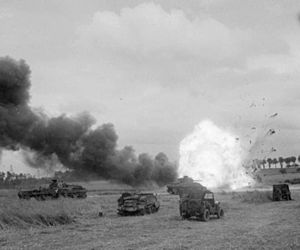
Back عملية إبسوم Arabic Operació Epsom Catalan Operation Epsom German Operaco Epsom Esperanto Operación Epsom Spanish Opération Epsom French Operasi Epsom ID Operazione Epsom Italian Operatie Epsom Dutch Operacja Epsom Polish
| Operation Epsom | |||||||
|---|---|---|---|---|---|---|---|
| Part of the Battle for Caen | |||||||
 An ammunition carrier of the British 11th Armoured Division explodes after it is hit by a mortar round during Operation Epsom, 26 June 1944. | |||||||
| |||||||
| Belligerents | |||||||
|
|
| ||||||
| Commanders and leaders | |||||||
|
|
| ||||||
| Strength | |||||||
|
2 infantry divisions 1 armoured division 1 armoured brigade 1 tank brigade |
3 SS panzer divisions 5 ad-hoc battle groups 1 SS heavy tank battalion | ||||||
| Casualties and losses | |||||||
|
4,020–4,900 casualties 150 tanks damaged or knocked out |
Over 3,000 casualties 125–126 tanks damaged or knocked out | ||||||
| Operation Epsom | |
|---|---|
| Operational scope | Strategic Offensive |
| Planned by | British Second Army |
| Objective | Break out of the bridgehead west of Caen, advance across the Orne River and capture the high ground south of Caen, near Bretteville-sur-Laize |
| Executed by | VIII Corps, Second Army; supporting attacks made by elements of XXX Corps. |
| Outcome | See Aftermath section |
Operation Epsom, also known as the First Battle of the Odon, was a British offensive in the Second World War between 26 and 30 June 1944, during the Battle of Normandy. The offensive was intended to outflank and seize the German-occupied city of Caen from the west, an important Allied objective, in the early stages of Operation Overlord, the Allied invasion of north-west Europe.
Preceded by Operation Martlet to secure the right flank of the advance, Operation Epsom began early on 26 June, with units of the 15th (Scottish) Infantry Division advancing behind a rolling artillery barrage. Air cover was sporadic for much of the operation, because poor weather in England forced the last-minute cancellation of bomber support. Accompanied by the 31st Tank Brigade, the 15th (Scottish) Division made steady progress and by the end of the first day had overrun much of the German outpost line, although some difficulties remained in securing the flanks. In mutually-costly fighting over the following two days, a foothold was secured across the River Odon and efforts were made to expand this, by capturing tactically valuable points around the salient and moving up the 43rd (Wessex) Infantry Division. By 30 June, after German counter-attacks, some of the British forces across the river were withdrawn and the captured ground consolidated, bringing the operation to a close.
Many casualties were suffered by both sides but unlike General Bernard Montgomery, the Allied commander in Normandy, Generalfeldmarschall Erwin Rommel was unable to withdraw units into reserve after the battle, as they were needed to hold the front line. The British retained the initiative, attacked several more times over the following two weeks and captured Caen in Operation Charnwood in mid-July. Interpretations of the intention and conduct of Operation Epsom differ but there is general agreement concerning its effect on the balance of forces in Normandy. The Germans contained the offensive but only by committing all their strength, including two panzer divisions just arrived in Normandy, which had been intended for an offensive against Allied positions around Bayeux.
© MMXXIII Rich X Search. We shall prevail. All rights reserved. Rich X Search
